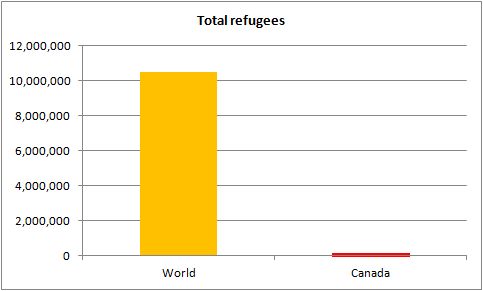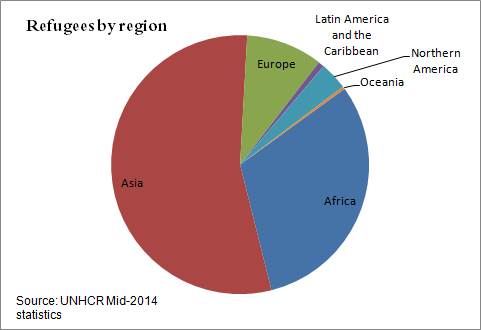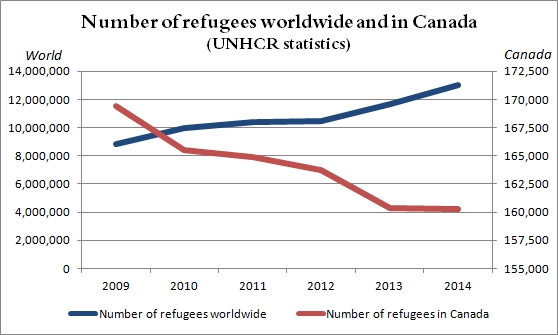Who is a refugee?
Refugees are people who are forced to leave their home countries because of serious human rights abuses.
The right to asylum from persecution is an international human right. It is guaranteed by the 1951 Convention relating to the Status of Refugees (the “Refugee Convention”).
According to this Convention, a refugee is a person:
who is outside his or her home country and who has a well-founded fear of being persecuted for reasons race, religion, nationality, membership of a particular social group or political opinion.
The Convention also spells out the key responsibilities of states towards refugees, which include the obligation not to send refugees back to the country where they face persecution. (This is known as the principle of “non-refoulement”).
What is the difference between a refugee, a refugee claimant and an immigrant?
Refugee – a person who is forced to flee from persecution and who is outside of their home country. We may also call this person a Convention refugee – a person who meets the refugee definition in the 1951 Geneva Convention relating to the Status of Refugees. This definition is used in Canadian law and is widely accepted internationally. To meet the definition, a person must be outside their country of origin and have a well-founded fear of being persecuted for reasons of race, religion, nationality, membership of a particular social group or political opinion.
Refugee claimant (or Asylum Seeker) – a person who has fled their country and is asking for protection in another country. We don’t know whether a claimant is a refugee or not until their case has been decided.
|
'Claimant’ is the term used in Canadian law. |
Resettled refugee – a person who has fled their country, is temporarily in a second country and then is offered a permanent home in a third country. Refugees resettled to Canada are selected abroad and become permanent residents as soon as they arrive in Canada.
|
Resettled refugees are determined to be refugees by the Canadian government before they arrive in Canada. Refugee claimants receive a decision on whether they are refugees after they arrive in Canada. |
Immigrant – a person who has settled permanently in another country.
|
What is the difference between a refugee and an immigrant? A refugee is forced to flee. An immigrant chooses to move to another country. |
Migrant – a person who is outside their country of origin. Sometimes this term is used to talk about everyone outside their country of birth, including people who have been Canadian citizens for decades. More often, it is used for people currently on the move or people with temporary status or no status at all in the country where they live.
You may also hear... Illegal migrant/illegal immigrant/Illegal – these terms criminalize the person, rather than the act of entering or remaining irregularly in a country. International law recognizes refugees may need to enter a country without official documents or authorization. It is misleading to describe them as “illegal migrants”. A person without status may have been coerced by traffickers and should be recognized as a victim of crime, not treated as a wrong-doer.
The UN Convention relating to the Status of Refugees (article 31) prohibits governments from penalizing refugees who enter or remain illegally on their territory. This is reflected in Canadian law (Immigration and Refugee Protection Act s. 133).
How do refugees come to Canada?
Refugees can come to Canada in two ways:
- Resettlement (where refugees who are outside Canada are selected overseas and then travel to Canada). This is a discretionary response, for which we have a moral obligation.
- The refugee claim process (where refugees who are inside Canada or at Canada’s borders have their claim to refugee status decided in Canada). Canada has legal obligations towards refugees in Canada: the most important is the obligation not to send them back to face persecution.
Did you know?
Canada welcomes very few of the world’s refugees. Canada hosts about 1.5% of the world’s refugees, according to the UNHCR.

Did you know...?
The vast majority of the world’s refugees are in the Global South. Only a tiny minority of refugees are found in Canada and the rest of the wealthiest countries.
Resettlement to Canada
Every year thousands of refugees are resettled to Canada from another country where they are staying temporarily. They may be living in a refugee camp, in urban areas or trying to survive in a country where they have no status and few, if any, rights. They may even be in detention or facing a risk of forced return to persecution. For them, resettlement to a third country such as Canada represents the only available solution. Resettlement provides protection and a durable solution (in other words, a permanent home).
The Canadian refugee resettlement program is composed of two categories:
- Government-assisted refugees, who receive support on their arrival from the government.
- Privately sponsored refugees, who receive support from private groups.
To qualify for resettlement in Canada, a refugee must:
- Be recognized as a refugee (or in a similar situation, as defined in the Canadian regulations)
- Not be barred on grounds of criminality, security risk, or danger to health
- Be considered capable of becoming “successfully established” in Canada
- Have no other reasonable prospect of a durable solution (that is they can’t go safely home, stay permanently with full rights in the country where they are or have an offer of resettlement to another country).
- Be supported financially, either by the government or by a private group.
Unique in the world, Canada’s Private Sponsorship of Refugees Program has allowed Canadians to offer protection and a new home to more than 225,000 refugees since its beginning in 1979.
However, the Program has been facing challenges because recent changes make private sponsorship more difficult (see CCR, Canada’s Private Sponsorship of Refugees Program: Proud history, Uncertain future)
Did you know...?
Refugees live in many different circumstances, not just in camps
Refugees are people who have been forced from their homes by human rights abuses. All refugees have a right to protection, wherever they are. Saying that some refugees are more deserving than others is the same as saying that some human beings are of less value than others.
Did you know...?
The number of refugees in Canada has been going down, while the number of refugees in the world has been increasing.
Refugee claims in Canada
A person fleeing persecution who is at Canada’s borders or within the country can ask for Canada’s protection by making a refugee claim.
The claim process has three main steps:
1. Eligibility. A claim is not eligible if the claimant:
- made a previous refugee claim in Canada.
- has refugee status in another country.
- arrived at the US-Canada border (with some exceptions)
- is inadmissible on certain security and criminality grounds.
2. Refugee determination
Eligible claims are referred to the Refugee Protection Division of the Immigration and Refugee Board, which determines whether the claimant:
- is a Convention refugee; or
- faces a danger of torture, or
- faces a risk to their life or of cruel and unusual treatment or punishment (and the risk is not generally faced by others and is not caused by inadequate health care).
If the IRB accepts the claim, the claimant becomes a Protected Person and can apply for permanent residence. They can include on the application immediate family members overseas).
Did you know?
The number of people making a refugee claim in Canada has gone down dramatically in recent years.

History of refugees in Canada
Explore the CCR's Brief history of Canada’s responses to refugees.



